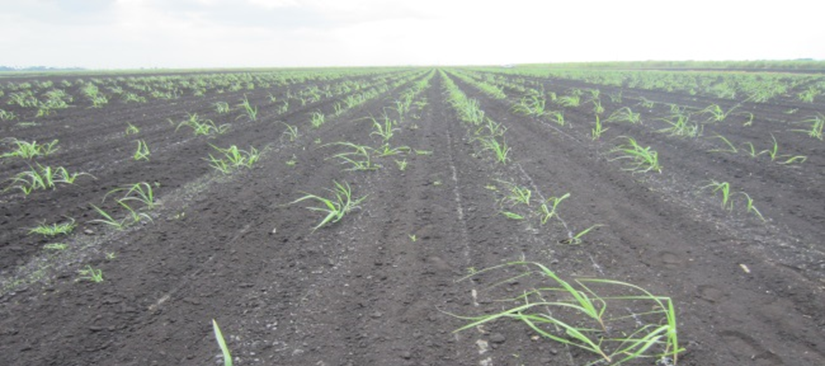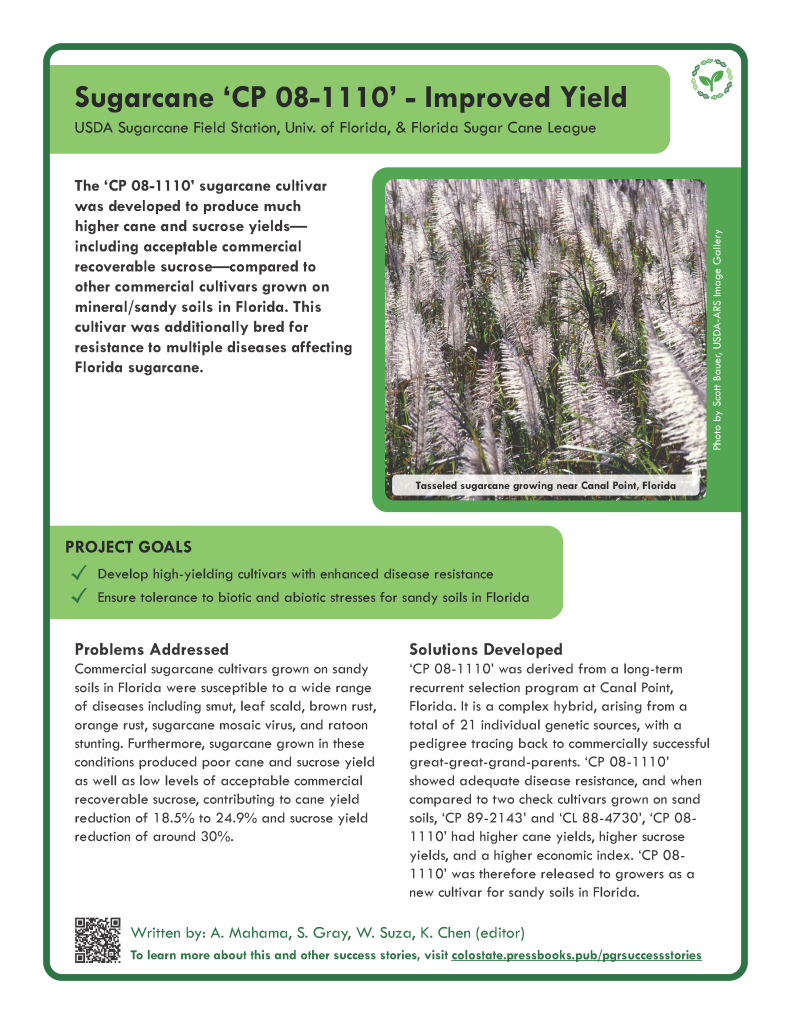Sugars, Starches, and Beverages
Sugarcane ‘CP 08-1110’ – Improved Yield
DEVELOPMENT OF ‘CP 08-1110’ SUGARCANE WITH DISEASE RESISTANCE AND HIGH CANE AND SUCROSE YIELDS
Anthony Mahama; Stephen Gray; and Walter Suza
Department of Agronomy, Iowa State University, Agronomy Hall 716 Farm House Ln, Ames, Iowa 50011.
Corresponding author: aamahama@iastate.edu
OUTLINE
1. SUMMARY

The ‘CP 08-1110’ sugarcane cultivar (PI 678579; Saccharum spp. hybrid) was developed with much higher cane and sucrose yields, and acceptable commercial recoverable sucrose than current commercial check cultivars (‘CP 89-2143’ and ‘CL 88-4730’) on mineral (sand) soils in Florida. It also has tolerance and acceptable levels of resistance to multiple diseases: brown rust (caused by Puccinia melanocephala, H. & P. Sydow), orange rust (caused by Puccinia kuehnii, E.J. Butler), leaf scald (caused by Xanthomonas albilineans, Ashby, Dowson), Sugarcane mosaic virus strain E, ratoon stunt (caused by Leifsonia xyli subsp. xyli, Evtsuhenko et al.), and smut (caused by Sporisorium scitamineum (Syd.), M. Piepenbring et al.).
The goal was to develop high-yielding cultivars with enhanced resistance or tolerance to biotic and abiotic stresses for muck and sandy soils in Florida.
Download a printable fact sheet by clicking the image below.
2. PROBLEMS ADDRESSED

Poor cane and sucrose yield and acceptable commercial recoverable sucrose of commercial cultivars on sandy soils and disease susceptibility in Florida contributed to cane yield reduction of 18.5% to 24.9% and sucrose yield reduction of around 30%.
3. SOLUTIONS DEVELOPED

‘CP 08-1110’ was derived from a long-term recurrent selection program and was selected from a biparental cross (‘CP 01-2459’ x ‘CP 00-2188’) using standard selection procedures (Zhao et al., 2017). It is a complex hybrid (arising from a total of 21 individual genetic sources) with a pedigree tracing back to great-great-grand-parents (a wild material, ‘IND 81-1446’ – PI 504789 and cultivar ‘Green German’ – PI 68052, five successful commercial cultivars – ‘CP 52-68’, which was released for commercial production in Louisiana (Heinz and Tew, 1987), ‘CP 70-1133’ (Rice et al., 1978), ‘CP 72-1210’ (Miller et al., 1981), ‘CP 72-2086’ (Miller et al., 1984), and ‘CP 74-2005’ (Tai et al., 1984) ), an introduced cultivar ‘R 567’ from Reunion, and the wide cross ‘US 94-1054’. Of these ancestral cultivars, CP 70-1133 and CP 72-2086 were the most widely grown sugarcane cultivars in Florida from 1982 to 1994 (Donovan and Glaz, 1985; Glaz, 1995). ‘CP 08-1110’ stands for the 110th (recorded 1110) selection assigned in the year 2008 (08) in the first clonal selection stage; CP refers to Canal Point.
Collaborators involved in developing solution:
- D. Zhao, J.C. Comstock, T. Abbott, V.S. Gordon, P.H. McCord, and S. Sood, USDA-ARS Sugarcane Field Station, Canal Point, Florida, USA
- M.P. Singh and H.S. Sandhu, University of Florida Everglades Research and Education Center, Belle Glade, Florida, USA
- R.W. Davidson and M. Baltazar, Florida Sugar Cane League, Clewiston, Florida, USA
4. IMPACT

‘CP 08-1110’ had 19.0 and 36.6% higher cane yields, respectively and 14.1 and 40.9% higher sucrose yields than two check cultivars ‘CP 89-2143’ and ‘CL 88-4730’ for sandy soils in final (Stage 4) yield trails. The economic index of ‘CP 08-1110’ was significantly (13.0% and 53.8%) higher than those of ‘CP 89-2143’ and ‘CL 88-4730’ on sandy soils. Therefore, ‘CP 08-1110’ was released to growers as a new cultivar for sandy soils only in Florida. In addition, ‘CP 08-1110’ has adequate resistance or tolerance to smut, leaf scald, brown rust, orange rust, sugarcane mosaic virus, and ratoon stunting for commercial production on sandy soils; however, it is susceptible to sugarcane yellow leaf virus, as are almost all sugarcane cultivars in Florida, and may have poor freeze tolerance compared with check cultivars.
5. GERMPLASM
The germplasm used to breed ‘CP 08-1110’ (PI 678579) was sourced from genebank accessions, previous cultivars, and crop wild relatives:
Male wild material ‘IND 81-146’ (PI 504789) and female cultivar ‘Green German’ (PI 68052) great-great grandparents from India, and several other lines as shown in the pedigree image below.

6. REFERENCES
Donovan WC, Glaz B. 1985. Florida’s 1985 sugar cane variety census. Sugar y Azucar 80: 36-40.
Glaz B. 1995. Sugar cane variety census: Florida 1994. Sugar y Azucar 90: 30-36.
Heinz DJ, Tew TL. 1987. Hybridization procedures. Developments in Crop Science 11:313-342. https://doi.org/10.1016/B978-0-444-42769-4.50013-8
Miller JD, Rice ER, Dean JL, Tai PYP. 1981. Registration of CP 72-1210 Sugarcane (Reg. No. 55). Crop Science 21:797. https://doi.org/10.2135/cropsci1981.0011183X002100050043x
Miller JD, Tai PYP, Glaz B, Dean JL, Kang MS. 1984. Registration of CP 72-2086 Sugarcane. Crop Science 24:210. https://doi.org/10.2135/cropsci1984.0011183X002400010055x
Rice ER, Miller JD, James NI, Dean JL. 1978. Registration of CP 70-1133 sugarcane. Crop Science 18:526. https://doi.org/10.2135/cropsci1978.0011183X001800030059x
Tai PYP, Miller JD, Glaz B, Dean JL, Kang MS. 1984. Registration of CP 74-2005 Sugarcane. Crop Science 24:210. https://doi.org/10.2135/cropsci1984.0011183X002400010054x
Zhao D, Comstock JC, Singh MP, Davidson RW, Abbott T, Gordon VS, Sandhu HS, McCord PH, Sood S, Baltazar M. 2017. Registration of ‘CP 08-1110’ Sugarcane. Journal of Plant Registrations 11:135-142. https://doi.org/10.3198/jpr2016.08.0041crc
7. CHAPTER INFORMATION
Citation: Mahama A, Gray S, Suza W. 2022. Sugarcane ‘CP 08-1110’ – Improved Yield. In: Volk GM, Chen K, Byrne P (Eds.) Plant Genetic Resources: Success Stories. Fort Collins, Colorado: Colorado State University. Date accessed. Available from https://colostate.pressbooks.pub/pgrsuccessstories/chapter/sugarcane-cp-08-1110-improved-yield/
Content originally submitted: May 31, 2022
Date of publication: July 2022
USDA is an equal opportunity provider, employer, and lender. Mention of trade names or commercial products in this article is solely for the purpose of providing specific information and does not imply recommendation or endorsement by the U.S. Department of Agriculture.


